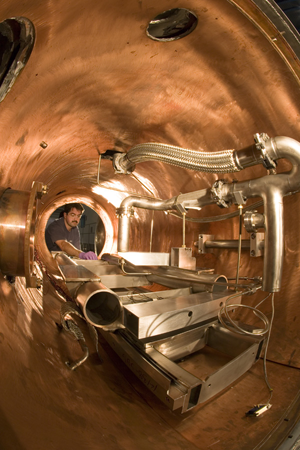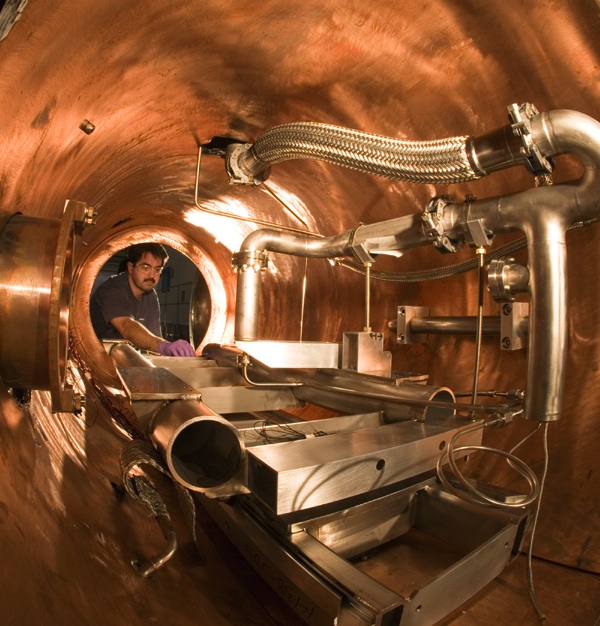Testing a Piece of the Next Generation Collider
The LHC, the new particle collider at CERN, is the world’s most powerful accelerator, but the post-LHC machines are already in development. Researchers have now demonstrated a prototype of the device that will generate the high-energy positrons (anti-electrons) that will collide with electrons in these future colliders, as they describe in Physical Review Letters. They showed that their design generates the precisely-configured magnetic fields needed to produce gamma rays that can slam into a target and make the most intense positron beam in history. Researchers need this intense beam to explore the particles expected to be discovered at the LHC in the next few years.
For over a decade, particle physicists have been planning the next big machines to follow up on the discoveries they expect to see at the LHC. These machines will probe the newly discovered particles with the higher precision of electron-positron collisions, rather than with proton-proton collisions. These future colliders, such as the International Linear Collider (ILC) and the Compact Linear Collider (CLIC), will require positron beams times more intense than existing positron sources, such as that at the Stanford Linear Collider at the SLAC National Accelerator Lab in California. Generating these positrons is one of the key design challenges for the next generation of colliders.
Conventional positron sources smash a high-energy electron beam into a metallic target, creating pairs of electrons and positrons. Those positrons are then collected and formed into bunches in another accelerator structure. However, the collision process damages the target, and it couldn’t withstand the much higher intensity electron beams that would be required for future machines.
An alternative approach is to use the electron beam to generate a high-intensity beam of photons, which would then hit a target and release positrons. To generate the photons, the electron beam would travel through a device called an undulator, which uses magnets to force the beam along a path that causes the electrons to emit photons with the right properties. Conventional undulators wiggle the electrons back and forth, usually causing them to emit linearly polarized photons in the forward direction. But the post-LHC experiments will require polarized positrons—particles with their spins aligned—which can be created by circularly polarized photons. To make these, the undulator must force electrons to follow a helical path.
A team led by Jim Clarke of the Daresbury Laboratory in England has now demonstrated that their undulator can produce the magnetic fields needed to generate the required photon beam. At the core of the undulator is an unusual helical winding of superconducting wires that wrap around the electron beam tube and generate strong magnetic fields. Coming up with the design involved optimizing a complicated set of parameters, such as the field strength, vessel material, and the pitch and diameter of the helical windings. They also needed the electron beam to remain relatively undisturbed, because the same beam that generates gamma rays will also be used for the collision experiments. The team used computer models and several prototypes to arrive at their final design.
Based on detailed magnetic field measurements, they report that gamma rays generated by the undulator will make about positrons per electron pulse—the ILC specification—even when the current in the superconducting wires is only of the maximum. This specification assumes that the ILC will have about of these undulators lined up in series to generate sufficient gamma rays.
Clarke and his colleagues say that undulators similar to theirs could also be used in other machines that require intense photon beams, such as synchrotrons and x-ray free-electron lasers. John Galayda of SLAC says the demonstration of the new undulator is an important step and agrees that it could be “very important to existing and future [x-ray] light sources.”
–David Harris
David Harris is a freelance science writer in Palo Alto, California.
References
- D. J. Scott, J. A. Clarke, D. E. Baynham, V. Bayliss, T. Bradshaw, G. Burton, A. Brummitt, S. Carr, A. Lintern, J. Rochford, O. Taylor, and Y. Ivanyushenkov, Phys. Rev. Lett. 107, 174803 (2011)





